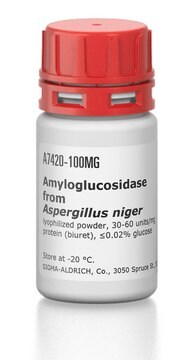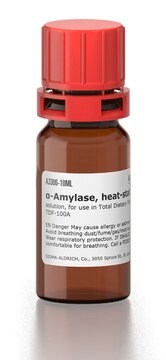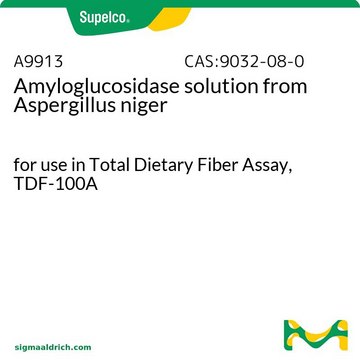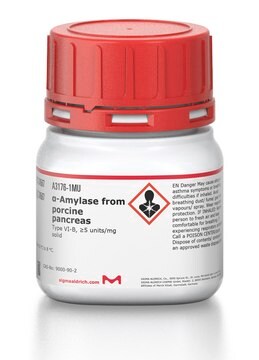A7095
Aminoglucosidasa from Aspergillus niger
≥260 U/mL, aqueous solution
Sinónimos:
1,4-α-D-Glucano glucohidrolasa, Exo-1,4-α-glucosidasa, Glucoamilasa
Iniciar sesiónpara Ver la Fijación de precios por contrato y de la organización
About This Item
Número de CAS:
MDL number:
UNSPSC Code:
12352204
NACRES:
NA.54
Productos recomendados
biological source
Aspergillus niger
Quality Level
form
aqueous solution
specific activity
≥260 U/mL
density
~1.2 g/mL at 25 °C
storage temp.
2-8°C
¿Está buscando productos similares? Visita Guía de comparación de productos
General description
Stabilized with glucose.
Amyloglucosidase is a disaccharidase−type alpha-glucosidase, produced by several species of Aspergillus genus. Immobilization of amyloglucosidase is known to increased its stability.
Amyloglucosidase is a disaccharidase−type alpha-glucosidase, produced by several species of Aspergillus genus. Immobilization of amyloglucosidase is known to increased its stability.
Application
Amyloglucosidase from Aspergillus niger has been used in in vitro digestions. It has also been used in the isolation of insoluble and soluble dietary fibre from quinoa and amaranth.
Biochem/physiol Actions
Amyloglucosidase from Aspergillus niger is capable of hydrolyzing the α-D-(1-4), the α-D-(1-6), and the α-D-(1-3) glucosidic bonds of oligosaccharides. Amyloglucosidase is an extracellular enzyme that converts starch to dextrins and glucose. The enzyme is used in the starch-processing industry for the commercial production of D-glucose from corn syrups.
Other Notes
View more information on enzymes for complex carbohydrate analysis at www.sigma-aldrich.com/enzymeexplorer
Legal Information
A product of Novozymes Corp.
AMG is a trademark of Novozymes Corp.
signalword
Danger
hcodes
pcodes
Hazard Classifications
Resp. Sens. 1
Storage Class
10 - Combustible liquids
wgk_germany
WGK 3
Elija entre una de las versiones más recientes:
¿Ya tiene este producto?
Encuentre la documentación para los productos que ha comprado recientemente en la Biblioteca de documentos.
Los clientes también vieron
Biodiversity: New Leads for the Pharmaceutical and Agrochemical Industries, 12(5), 183-183 (2000)
Effect of two barley beta-glucan concentrates on in vitro glycaemic impact and cooking quality of spaghetti
Chillo, S and Ranawana, DV and Henry, CJK
Food Sci. Technol., 44(4), 940-948 (2011)
Quinoa (Chenopodium quinoa W.) and amaranth (Amaranthus caudatus L.) provide dietary fibres high in pectic substances and xyloglucans
Lamothe Lisa M, et al.
Food Chemistry, 167(4), 490-496 (2015)
Recent Advances in Basic and Applied Aspects of Industrial Catalysis, 891-891 (1998)
Fandila Carlos-Amaya et al.
Journal of agricultural and food chemistry, 59(4), 1376-1382 (2011-01-11)
Banana starch was chemically modified using single (esterification or cross-linking) and dual modification (esterification-cross-linking and cross-linking-esterification), with the objective to increase the slowly digestible starch (SDS) and resistant starch (RS) concentrations. Physicochemical properties and in vitro digestibility were analyzed. The
Nuestro equipo de científicos tiene experiencia en todas las áreas de investigación: Ciencias de la vida, Ciencia de los materiales, Síntesis química, Cromatografía, Analítica y muchas otras.
Póngase en contacto con el Servicio técnico










